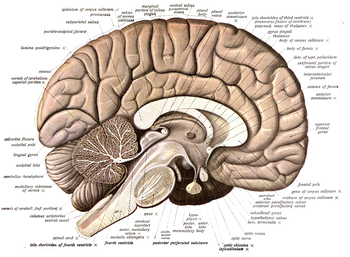
Back تشريح عصبي Arabic Neuroanatomija BS Neuroanatomia Catalan Neuroanatomi Danish Neuroanatomie German Νευροανατομία Greek Neuroanatomía Spanish Neuroanatoomia Estonian نوروآناتومی Persian Neuroanatomia Finnish

Neuroanatomy is the study of the structure and organization of the nervous system. In contrast to animals with radial symmetry, whose nervous system consists of a distributed network of cells, animals with bilateral symmetry have segregated, defined nervous systems. Their neuroanatomy is therefore better understood. In vertebrates, the nervous system is segregated into the internal structure of the brain and spinal cord (together called the central nervous system, or CNS) and the series of nerves that connect the CNS to the rest of the body (known as the peripheral nervous system, or PNS). Breaking down and identifying specific parts of the nervous system has been crucial for figuring out how it operates. For example, much of what neuroscientists have learned comes from observing how damage or "lesions" to specific brain areas affects behavior or other neural functions.
For information about the composition of non-human animal nervous systems, see nervous system. For information about the typical structure of the Homo sapiens nervous system, see human brain or peripheral nervous system. This article discusses information pertinent to the study of neuroanatomy.
© MMXXIII Rich X Search. We shall prevail. All rights reserved. Rich X Search